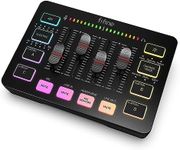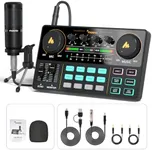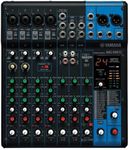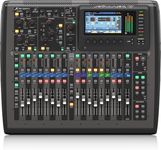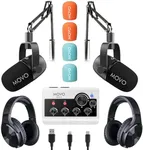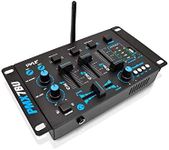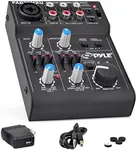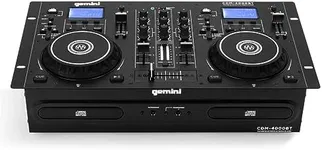Buying Guide for the Best Podcast Mixers
Choosing the right podcast mixer can significantly enhance the quality of your recordings and make the production process smoother. A podcast mixer allows you to control and adjust audio levels, add effects, and manage multiple audio sources. When selecting a podcast mixer, it's important to consider your specific needs, such as the number of participants, the type of content you produce, and your level of technical expertise. Here are some key specifications to consider when choosing a podcast mixer and how to navigate them to find the best fit for you.Number of ChannelsThe number of channels on a mixer determines how many audio sources you can connect and control simultaneously. This is important because it dictates how many microphones, instruments, or other audio inputs you can use at once. Mixers typically range from 2 to 16 or more channels. If you're a solo podcaster or have a small team, a mixer with 2-4 channels might suffice. For larger groups or more complex setups, consider a mixer with 8 or more channels. Assess the number of participants and audio sources in your podcast to determine the right number of channels for you.
Built-in EffectsBuilt-in effects, such as reverb, compression, and equalization, can enhance the sound quality of your recordings. These effects are important for creating a polished and professional-sounding podcast. Mixers with built-in effects allow you to adjust and fine-tune your audio without needing additional equipment. If you want to add depth and clarity to your recordings, look for a mixer with a variety of built-in effects. However, if you prefer to keep things simple or plan to use external software for effects, a basic mixer without built-in effects may be sufficient.
USB ConnectivityUSB connectivity allows you to connect your mixer directly to a computer for recording and streaming. This is crucial for podcasters who want to record digitally or broadcast live. Mixers with USB connectivity can simplify your setup and provide a direct link to your recording software. If you plan to record your podcast on a computer or stream live, ensure the mixer you choose has USB connectivity. For those who prefer to record on external devices or use analog setups, USB connectivity may not be as critical.
Phantom PowerPhantom power is a feature that supplies power to condenser microphones, which are commonly used in podcasting for their sensitivity and sound quality. This is important because without phantom power, condenser microphones won't function. Mixers with phantom power can support a wider range of microphones, giving you more flexibility in your equipment choices. If you plan to use condenser microphones, make sure your mixer has phantom power. If you only use dynamic microphones, which do not require phantom power, this feature may not be necessary.
PortabilityPortability refers to the ease with which you can transport and set up your mixer. This is important for podcasters who record in different locations or travel frequently. Portable mixers are typically smaller, lighter, and easier to set up. If you need to move your recording setup often or record on the go, look for a compact and lightweight mixer. For those who have a dedicated recording space and don't need to move their equipment, portability may be less of a concern.
Ease of UseEase of use refers to how user-friendly and intuitive the mixer is. This is important because a complicated mixer can slow down your workflow and make recording more difficult. Mixers with clear labeling, simple controls, and good documentation are easier to use, especially for beginners. If you're new to podcasting or prefer a straightforward setup, look for a mixer that is known for its ease of use. More experienced users might be comfortable with a more complex mixer that offers advanced features and greater control.
